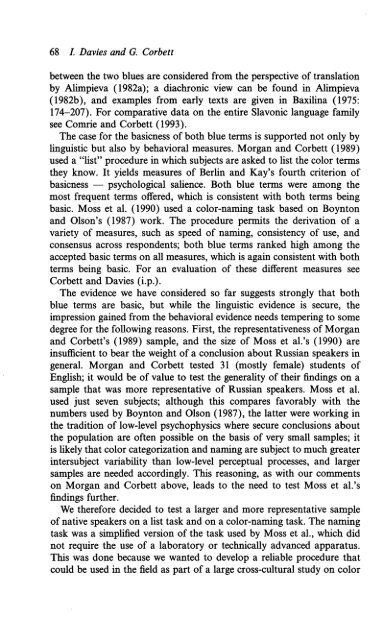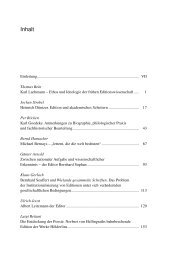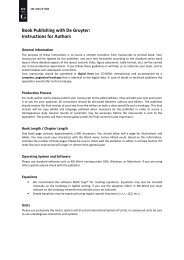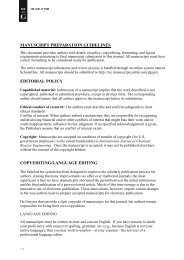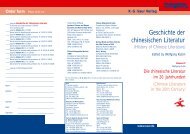The basic color terms of Russian* - Walter de Gruyter
The basic color terms of Russian* - Walter de Gruyter
The basic color terms of Russian* - Walter de Gruyter
You also want an ePaper? Increase the reach of your titles
YUMPU automatically turns print PDFs into web optimized ePapers that Google loves.
68 /. Davies and G. Corbett<br />
between the two blues are consi<strong>de</strong>red from the perspective <strong>of</strong> translation<br />
by Alimpieva (1982a); a diachronic view can be found in Alimpieva<br />
(1982b), and examples from early texts are given in Baxilina (1975:<br />
174-207). For comparative data on the entire Slavonic language family<br />
see Comrie and Corbett (1993).<br />
<strong>The</strong> case for the <strong>basic</strong>ness <strong>of</strong> both blue <strong>terms</strong> is supported not only by<br />
linguistic but also by behavioral measures. Morgan and Corbett (1989)<br />
used a "list" procedure in which subjects are asked to list the <strong>color</strong> <strong>terms</strong><br />
they know. It yields measures <strong>of</strong> Berlin and Kay's fourth criterion <strong>of</strong><br />
<strong>basic</strong>ness — psychological salience. Both blue <strong>terms</strong> were among the<br />
most frequent <strong>terms</strong> <strong>of</strong>fered, which is consistent with both <strong>terms</strong> being<br />
<strong>basic</strong>. Moss et al. (1990) used a <strong>color</strong>-naming task based on Boynton<br />
and Olson's (1987) work. <strong>The</strong> procedure permits the <strong>de</strong>rivation <strong>of</strong> a<br />
variety <strong>of</strong> measures, such as speed <strong>of</strong> naming, consistency <strong>of</strong> use, and<br />
consensus across respon<strong>de</strong>nts; both blue <strong>terms</strong> ranked high among the<br />
accepted <strong>basic</strong> <strong>terms</strong> on all measures, which is again consistent with both<br />
<strong>terms</strong> being <strong>basic</strong>. For an evaluation <strong>of</strong> these different measures see<br />
Corbett and Davies (i.p.)·<br />
<strong>The</strong> evi<strong>de</strong>nce we have consi<strong>de</strong>red so far suggests strongly that both<br />
blue <strong>terms</strong> are <strong>basic</strong>, but while the linguistic evi<strong>de</strong>nce is secure, the<br />
impression gained from the behavioral evi<strong>de</strong>nce needs tempering to some<br />
<strong>de</strong>gree for the following reasons. First, the representativeness <strong>of</strong> Morgan<br />
and Corbett's (1989) sample, and the size <strong>of</strong> Moss et al.'s (1990) are<br />
insufficient to bear the weight <strong>of</strong> a conclusion about Russian speakers in<br />
general. Morgan and Corbett tested 31 (mostly female) stu<strong>de</strong>nts <strong>of</strong><br />
English; it would be <strong>of</strong> value to test the generality <strong>of</strong> their findings on a<br />
sample that was more representative <strong>of</strong> Russian speakers. Moss et al.<br />
used just seven subjects; although this compares favorably with the<br />
numbers used by Boynton and Olson (1987), the latter were working in<br />
the tradition <strong>of</strong> low-level psychophysics where secure conclusions about<br />
the population are <strong>of</strong>ten possible on the basis <strong>of</strong> very small samples; it<br />
is likely that <strong>color</strong> categorization and naming are subject to much greater<br />
intersubject variability than low-level perceptual processes, and larger<br />
samples are nee<strong>de</strong>d accordingly. This reasoning, as with our comments<br />
on Morgan and Corbett above, leads to the need to test Moss et al.'s<br />
findings further.<br />
We therefore <strong>de</strong>ci<strong>de</strong>d to test a larger and more representative sample<br />
<strong>of</strong> native speakers on a list task and on a <strong>color</strong>-naming task. <strong>The</strong> naming<br />
task was a simplified version <strong>of</strong> the task used by Moss et al., which did<br />
not require the use <strong>of</strong> a laboratory or technically advanced apparatus.<br />
This was done because we wanted to <strong>de</strong>velop a reliable procedure that<br />
could be used in the field as part <strong>of</strong> a large cross-cultural study on <strong>color</strong>


